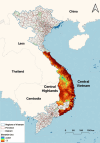Bayesian spatio-temporal modelling of environmental, climatic, and socio-economic influences on malaria in Central Vietnam
- PMID: 39182127
- PMCID: PMC11344946
- DOI: 10.1186/s12936-024-05074-y
Bayesian spatio-temporal modelling of environmental, climatic, and socio-economic influences on malaria in Central Vietnam
Abstract
Background: Despite the successful efforts in controlling malaria in Vietnam, the disease remains a significant health concern, particularly in Central Vietnam. This study aimed to assess correlations between environmental, climatic, and socio-economic factors in the district with malaria cases.
Methods: The study was conducted in 15 provinces in Central Vietnam from January 2018 to December 2022. Monthly malaria cases were obtained from the Institute of Malariology, Parasitology, and Entomology Quy Nhon, Vietnam. Environmental, climatic, and socio-economic data were retrieved using a Google Earth Engine script. A multivariable Zero-inflated Poisson regression was undertaken using a Bayesian framework with spatial and spatiotemporal random effects with a conditional autoregressive prior structure. The posterior random effects were estimated using Bayesian Markov Chain Monte Carlo simulation with Gibbs sampling.
Results: There was a total of 5,985 Plasmodium falciparum and 2,623 Plasmodium vivax cases during the study period. Plasmodium falciparum risk increased by five times (95% credible interval [CrI] 4.37, 6.74) for each 1-unit increase of normalized difference vegetation index (NDVI) without lag and by 8% (95% CrI 7%, 9%) for every 1ºC increase in maximum temperature (TMAX) at a 6-month lag. While a decrease in risk of 1% (95% CrI 0%, 1%) for a 1 mm increase in precipitation with a 6-month lag was observed. A 1-unit increase in NDVI at a 1-month lag was associated with a four-fold increase (95% CrI 2.95, 4.90) in risk of P. vivax. In addition, the risk increased by 6% (95% CrI 5%, 7%) and 3% (95% CrI 1%, 5%) for each 1ºC increase in land surface temperature during daytime with a 6-month lag and TMAX at a 4-month lag, respectively. Spatial analysis showed a higher mean malaria risk of both species in the Central Highlands and southeast parts of Central Vietnam and a lower risk in the northern and north-western areas.
Conclusion: Identification of environmental, climatic, and socio-economic risk factors and spatial malaria clusters are crucial for designing adaptive strategies to maximize the impact of limited public health resources toward eliminating malaria in Vietnam.
Keywords: Plasmodium; Bayesian; Malaria; Spatio-temporal; Vector-borne disease; Vietnam.
© 2024. The Author(s).
Conflict of interest statement
The authors declare no competing interests.
Figures






Similar articles
-
Analysis of clinical malaria disease patterns and trends in Vietnam 2009-2015.Malar J. 2018 Sep 17;17(1):332. doi: 10.1186/s12936-018-2478-z. Malar J. 2018. PMID: 30223843 Free PMC article.
-
Spatial and Temporal Patterns of Malaria in Phu Yen Province, Vietnam, from 2005 to 2016.Am J Trop Med Hyg. 2020 Oct;103(4):1540-1548. doi: 10.4269/ajtmh.20-0392. Am J Trop Med Hyg. 2020. PMID: 32748781 Free PMC article.
-
Spatial patterns and climate drivers of malaria in three border areas of Brazil, Venezuela and Guyana, 2016-2018.Sci Rep. 2022 Jun 29;12(1):10995. doi: 10.1038/s41598-022-14012-4. Sci Rep. 2022. PMID: 35768450 Free PMC article.
-
A spatio-temporal analysis to identify the drivers of malaria transmission in Bhutan.Sci Rep. 2020 Apr 27;10(1):7060. doi: 10.1038/s41598-020-63896-7. Sci Rep. 2020. PMID: 32341415 Free PMC article.
-
Plasmodium vivax in the Era of the Shrinking P. falciparum Map.Trends Parasitol. 2020 Jun;36(6):560-570. doi: 10.1016/j.pt.2020.03.009. Epub 2020 Apr 22. Trends Parasitol. 2020. PMID: 32407682 Free PMC article. Review.
References
-
- WHO. World malaria report 2022. Geneva, World Health Organization, 2022.
MeSH terms
Grants and funding
LinkOut - more resources
Full Text Sources

